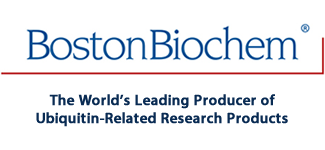
Recombinant Human His6-UBE2N/Ubc13 Protein, CF Summary
Product Datasheets
Carrier Free
CF stands for Carrier Free (CF). We typically add Bovine Serum Albumin (BSA) as a carrier protein to our recombinant proteins.Adding a carrier protein enhances protein stability, increases shelf-life, and allows the recombinant protein to be stored at a more dilute concentration.The carrier free version does not contain BSA.
In general, we advise purchasing the recombinant protein with BSA for use in cell or tissue culture, or as an ELISA standard.In contrast, the carrier free protein is recommended for applications, in which the presence of BSA could interfere.
E2-660
| Formulation | X mg/ml (X μM) in 50 mM HEPES pH 7.5, 200 mM NaCl, 10% Glycerol (v/v), 1 mM TCEP |
| Shipping | The product is shipped with dry ice or equivalent. Upon receipt, store it immediately at the temperature recommended below. |
| Stability & Storage: | Use a manual defrost freezer and avoid repeated freeze-thaw cycles.
|
Reconstitution Calculator
Background: UBE2N/Ubc13
Ubiquitin-conjugating Enzyme E2N (UBE2N), also known as Ubiquitin-conjugating Enzyme 13 (Ubc13), is a member of the Ubiquitin-conjugating (E2) enzyme family. UBE2N/Ubc13 has a predicted molecular weight of 17 kDa. The human enzyme shares 100% and 99% amino acid sequence identity with its mouse and rat orthologs, respectively. UBE2N/Ubc13 has an E2 catalytic core domain with an active site cysteine residue that is required for the formation of a thioester bond with Ubiquitin (1). UBE2N/Ubc13 localizes to both the nucleus and cytoplasm (2). UBE2N/Ubc13 forms heterodimeric complexes with Uev1a/UBE2V1 and Mms2, both of which are catalytically inactive E2 enzyme variants. The UBE2N (Ubc13)/Uev1A Complex is found in the cytoplasm and is important for inflammatory responses via Nuclear Factor kappaB (NF-kappa B) activation (3,4). In contrast, the UBE2N/Ubc13-Mms2 complex functions in the nucleus and is required for an efficient DNA damage response (3,5-7). Pathologically, UBE2N (Ubc13)/Uev1a Complex-mediated NF-kappa B activation is required for the proliferation of diffuse large B-cell lymphoma cells (8). This protein has an N-terminal His6-tag.
- Hershko, A. et al. (1983) J. Biol. Chem. 258:8206.
- Laine, A. et al. (2006) Mol. Cell. Biol. 26:8901.
- Andersen, P.L. et al. (2005) J. Cell Biol. 170:745.
- Pertel, T. et al. (2011) Nature 472:361.
- Zhao, G.Y. et al. (2007) Mol. Cell 25:663.
- Stewart, G.S. et al. (2009) Cell 136:420.
- Campbell, S.J. et al. (2012) J. Biol. Chem. 287:23900.
- Pulvino, M. et al. (2012) Blood 120:1668.
Citation for Recombinant Human His6-UBE2N/Ubc13 Protein, CF
R&D Systems personnel manually curate a database that contains references using R&D Systems products.The data collected includes not only links to publications in PubMed,but also provides information about sample types, species, and experimental conditions.
1Citation: Showing 1 - 1
- Legionella pneumophila inhibits immune signalling via MavC-mediated transglutaminase-induced ubiquitination of UBE2NAuthors: N Gan, ES Nakayasu, PJ Hollenbeck, ZQ LuoNat Microbiol, 2019;4(1):134-143.Species: HumanSample Types: ProteinApplications: Bioassay
FAQs
No product specific FAQs exist for this product, however you may
View all Proteins and Enzyme FAQsRecombinant Enzymes
Recombinant Human His6-UBE2N/UBE2V2 Complex Protein, CF
Recombinant Proteins
Recombinant Human SUMO2 Protein, CF
Recombinant Human Ubiquitin Protein, CF
Ubiquitin E3 Ligase Kits
Human CHIP Ubiquitin Ligase Kit - Glow-Fold Substrate
Reviews for Recombinant Human His6-UBE2N/Ubc13 Protein, CF
There are currently no reviews for this product. Be the first toreview Recombinant Human His6-UBE2N/Ubc13 Protein, CF and earn rewards!
Have you used Recombinant Human His6-UBE2N/Ubc13 Protein, CF?
Submit a review and receive an Amazon gift card.
$25/€18/£15/$25CAN/¥75 Yuan/¥1250 Yen for a review with an image
$10/€7/£6/$10 CAD/¥70 Yuan/¥1110 Yen for a review without an image
ebiomall.com






>
>
>
>
>
>
>
>
>
>
>
>
患者,双手扶墙,脚尖着地;医生做好消毒,戴上手套,利用放血针(可以利用测血糖的放血针),在委中穴点刺放血,利用拔罐器把瘀血抽出来,直到见到新鲜血液为止。委中穴是解毒大穴。
中医强调治症不治病,虽然身体还有病毒,但是,只要症状能够解除,不影响正常生活和工作,就可以了。
需要强调:医生,一定要做好消毒、保护,防止病毒感染。 另外,可以把艾滋病作为一种疫病,尝试五苓散;五苓散是用来治疗疫病的。
核心抗原由183个或185个氨基酸组成,高度磷酸化,是乙肝病毒核心颗粒的唯一结构蛋白。正由于它存在于Dane颗粒核心结构表面,被表面抗原覆盖,故不易在血循环中检出。核心抗原具有强免疫原性,可诱导很强的体液免疫和细胞免疫,刺激机体产生抗-HBc。
e抗原为可溶性蛋白质,传染性强,游离存在于血液中,虽然很早就被发现,在病理上认为是HBV复制以具有强感染性的一个指标,但其功能尚不清楚。抗-HBe的出现,是预后良好的征象。向左转|向右转
主要是中度以上细胞免疫缺陷包括:CD4+T淋巴细胞耗竭,外周血淋巴细胞显著减少,CD4<200/μl,CD4/CD8<1.0,(正常人为1.25~2.1),迟发型变态反应皮试阴性,有丝分裂原刺激反应低下。NK细胞活性下降。
2.各种致病性感染的病原体检查
如用PCR方法检测相关病原体,恶性肿瘤的组织病理学检查。
3.HIV抗体检测
采用酶联免疫吸附法、明胶颗粒凝集试验、免疫荧光检测法、免疫印迹检测法、放射免疫沉淀法等,其中前三项常用于筛选试验,后二者用于确证试验。
4.PCR技术检测HIV病毒。
流感病毒的基因组包含________基因,其中__________蛋白可作为__________的结构基础.
我不知道第一空如何填,第二空是否应该填"HA蛋白"?第3空是否应该填"突变"?
多谢各位啊!
新年快乐!
万事如意!
1、存在于细胞外环境时,不显复制活性,但保持感染活性,是病毒体或病毒颗粒形式。
2、抗原,是指能够刺激机体产生(特异性)免疫应答,并能与免疫应答产物抗体和致敏淋巴细胞在体外结合,发生免疫效应(特异性反应)的物质









